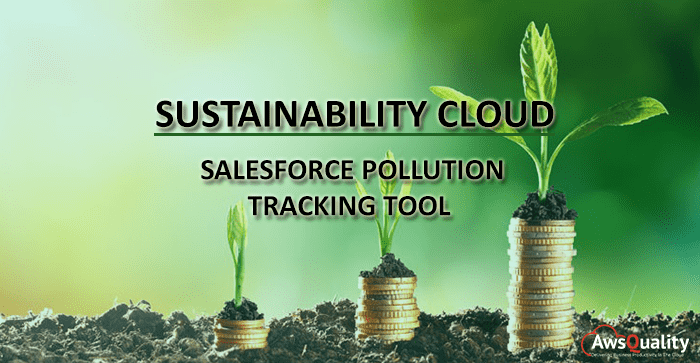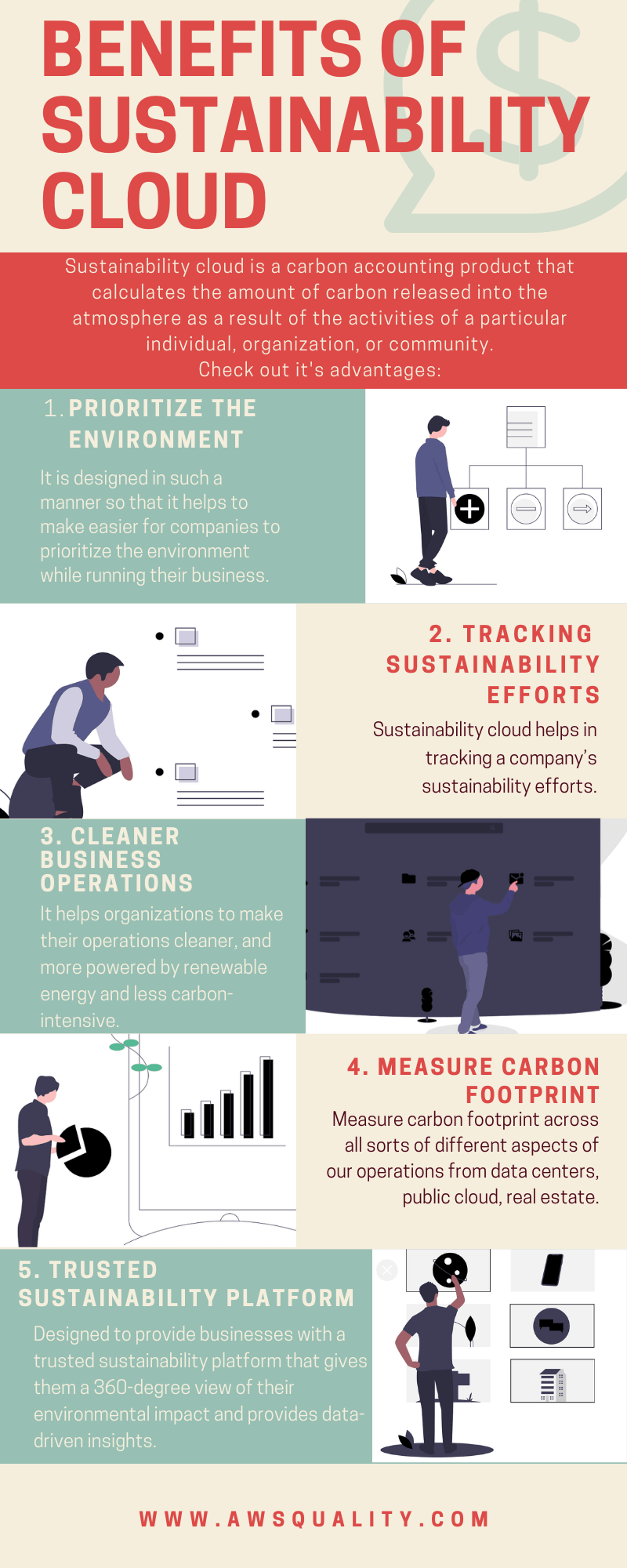
To always emphasize working in the community for its employees, Salesforce has always been concerned with becoming a socially responsible business. The most enormous, significant, and complicated challenge people face is climate change. Everybody needs to take action—both as an individual and a business—to address this issue.
Additionally, look into Salesforce Manufacturing Cloud for Better Transparency to Manufacturers. By creating a new technology called Sustainability Cloud, Salesforce is now moving forward to assist other firms in lowering their carbon footprints.
Salesforce has unveiled Sustainability Cloud, a new platform that primarily aims to support organizations in taking action to combat climate change. It is a carbon accounting tool that determines how much carbon is emitted into the atmosphere due to a specific person, business, or community’s operations.
Also check: Better Transparency to Manufacturers with Salesforce Manufacturing Cloud
Here are some of the benefits of Sustainability Cloud listed below…

Salesforce Sustainability Cloud Features
Accounting for Carbon under Scopes 1, 2, and 3
Salesforce Sustainability Cloud calculates carbon emissions based on energy use, billing information, and spending data. All emissions must be considered if you want to put an effective environmental strategy into place. Salesforce Sustainability Cloud offers three kinds of greenhouse gases for businesses to make better decisions. Building emissions (heating and cooling), company shuttles, and corporate jet travel are included in scope 1; data Centre electricity consumption and electricity purchased for personal use are included in scope 2; and purchased goods, fuel-related activities, upstream transportation and distribution, upstream leased assets, waste generated during operations, and investments are included in scope 3.
The entire set of global reference data
Sustainability Cloud Salesforce provides a comprehensive global reference dataset that enables enterprises to contrast their collected and reported data to develop more effective sustainability plans. Although compiling such data can take weeks, it is already done in one location, making it simple for those involved in adopting, putting into practice, and assessing their environmental impact to use the knowledge to lower their carbon emissions. With this solution, you may access carbon accounting and preload datasets from the U.S. EPA, IPCC, and many other sources.
Automatic Quality Controls for Data
Since lousy data is the source of incomplete and inaccurate information, it is the primary cause of project failure. Salesforce Sustainability might offer an automated version of this procedure to keep data from being incorrect or unclear. Your reporting will be as accurate as possible and will support the development of effective environmental action plans.
Tracking the Allocation of Renewable Energy
Businesses must track the source of clean and renewable energy to ensure that it is generated according to Sustainability Management Solutions. Renewable energy allocation tracking is a feature of Salesforce’s sustainable cloud that makes it much simpler to identify the energy source used. This helps you choose the most environmentally friendly energy source you can employ for your company and monitor the essential environmental data so you can make correct data-driven climate decisions.
Tracking Energy and Emissions Variance
Monitoring energy use and emissions is one of the best ways for companies to improve operational effectiveness and sustainability. Salesforce Sustainability Cloud offers an accurate report of energy and emissions variance data that your firm can use to enhance stakeholder communication and create more effective climate policy. Businesses steer clear of irrational energy expenditures and increase their understanding of energy usage patterns.
Dashboards and Reports are pre-built
Obtain information about your company’s environmental impact with thorough and reliable reports and dashboards. They assist in keeping track of all current emissions and produce specific, data-driven cases that will undoubtedly aid your team in coming up with the best answers and choosing the best course of action for your climate action strategy.
The benefits of using the cloud, which include security, flexibility, and cost-effectiveness, are operated by 94% of businesses. However, sustainability is a cloud computing benefit that every company should be aware of.
Carbon emissions have increased along with the growth of large enterprises. However, implementing the cloud can significantly reduce your company’s carbon footprint. In fact, according to Microsoft, the use of the cloud has reduced carbon emissions by 98%, and according to AWS, another top cloud provider, the cloud is 88% more energy-efficient than on-premise data Centres.
This piece covers the advantages of cloud-based solutions for the environment in further detail.
Remote employment options
Working remotely has become increasingly popular over the last five years, and its advantages are now fully realized. With the capacity to hire personnel from anywhere, businesses can now expand bigger, better, and faster thanks to cloud computing.
Today, 55% of global brands provide some remote employment options.
That means that more than half of the workforce spends less time driving or using public transportation, which lowers carbon emissions.
With everything increasingly being done on screens, offices require less energy to run and fewer physical resources. Additionally, since documents can be signed electronically, cloud-based systems like DocuSign eliminate the need to print paper copies. All of this is good news for the environment.
Brings down carbon emissions
Large, heat-generating buildings that use a lot of resources are what data centers usually are like. The most extensive data Centre in the world consumes 100 megawatts of power, which is sufficient to power 80,000 houses, according to the IEA, which found that data Centre’s accounted for 1.1.4% of the world’s electricity consumption in 2020.
By minimizing energy needs and consumption, cloud computing helps lower carbon emissions.
By effectively managing electricity capacity, optimizing cooling, utilizing power-efficient servers, and raising server utilization rates, consolidating discrete enterprise data Centres into larger-scale facilities can reduce CO2 emissions.
Utilizing renewable energy
Additionally, many cloud data Centres are fueled by renewable energy sources, including solar, wind, and hydropower, which emit very little to no greenhouse gases.
These processes are significantly less harmful to the environment than fossil fuels, which today provide 80% of the world’s energy, and coal is the single most significant cause of climate change.
The environment might benefit significantly if all firms migrated to cloud computing powered by renewable energy.
The use of renewable energy is being pioneered by some of the essential tech businesses in the world, including Google, Apple, Microsoft, HP, and Facebook.
Decreases e-waste
The issue of e-waste is escalating quickly. Over 9 million tons of electrical waste had been disposed of just in 2022; for comparison, that is four times the weight of the Burj Khalifa, the highest structure in the world. If businesses and consumers keep their behavior the same, it will reach 120 million tonnes by 2050.
One of the most eco-friendly ways to reduce waste is through cloud computing. Adopting cloud-based solutions frees businesses from the need to constantly repair or replace end-user gear like laptops, keyboards, mice, and monitors. Most of the processing and storing will be handled by the hosting firm’s servers.
Additionally, unlike previous technologies, cloud computing does not mandate that users dispose of outdated equipment. Instead, the cloud gives them new life. Cloud computing lowers e-waste by reducing hardware. Because employees may access cloud-hosted applications from their personal computers, tablets, and cellphones, organizations may not even need to buy any new hardware.
Few advantages of the Sustainability Cloud.
- It is made to make it simpler for businesses to put the environment first when conducting their operations.
- It encourages climate action that will hasten global efforts to become carbon neutral.
- Aid in monitoring a company’s sustainability initiatives.
- It is enabling all businesses to spearhead effective climate action.
- Carbon emissions and the use of renewable energy are easily tracked.
- It aids in achieving the organization’s sustainability objectives.
- Works with both internal and outside data as necessary.
- Measure the carbon impact of every facet of our business, including data Centre, the public cloud, and real estate.
- Both an internal audit by the Sustainability team and an external audit by third parties.
- It enables businesses to run less polluting, carbon-intensive, and more renewable energy-based operations.
- It aids in quickening global efforts to achieve carbon neutrality.
- It was created to give companies a dependable sustainability platform that allows them to see their environmental effect from all angles and offers data-driven insights to make changes that the environment will notice.
- Reliable environmental data can be quickly tracked, analyzed, and reported to assist businesses in cutting their carbon emissions.
- Salesforce Einstein Analytics, which generates dynamic reports and dashboards for audit reasons and executive involvement, makes it simple to track carbon data for an enterprise.
- With profound insights that enable corporations to spearhead large-scale climate change initiatives.
- Considering various points of view, we have concluded that Salesforce is dedicated to bringing about a low-carbon, sustainable future and supports the UN Sustainable Development Goals (SDGs), which serve as the framework for the company’s worldwide strategy and technological advancements.
Facing any difficulty regarding this topic, our team provides affordable and effective Salesforce Consulting Services. To find out more, contact us today.
Also, check our Salesforce Development Service.




